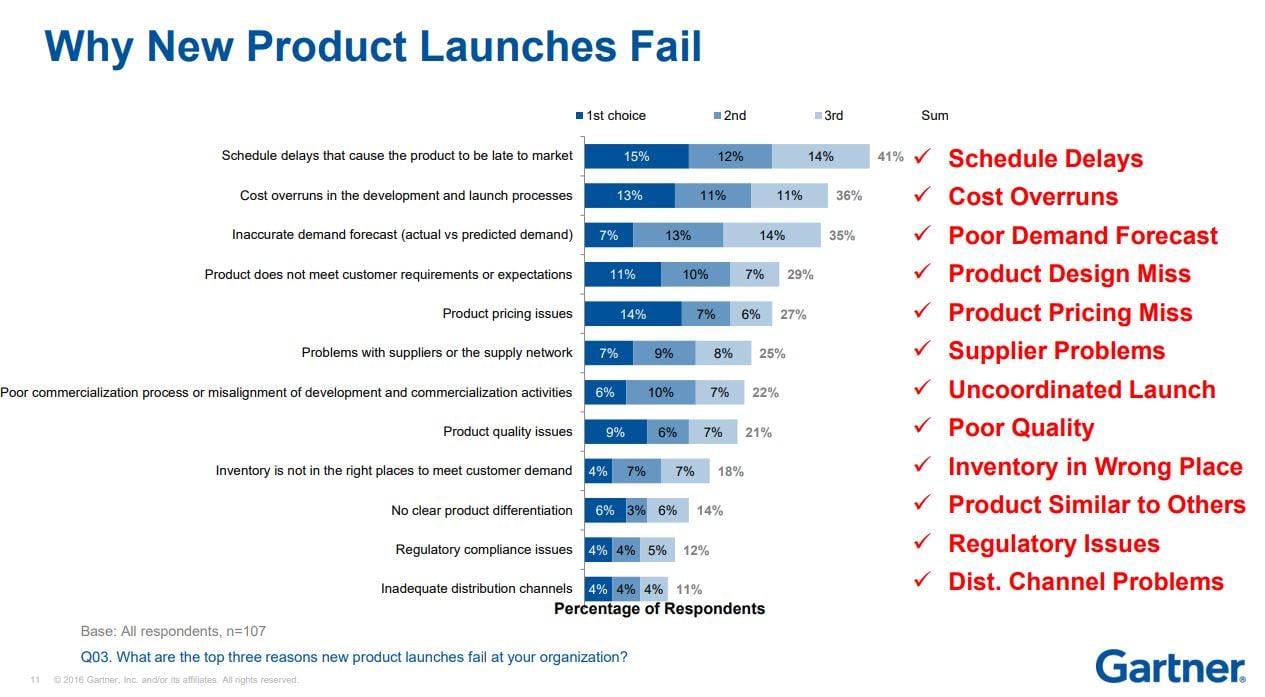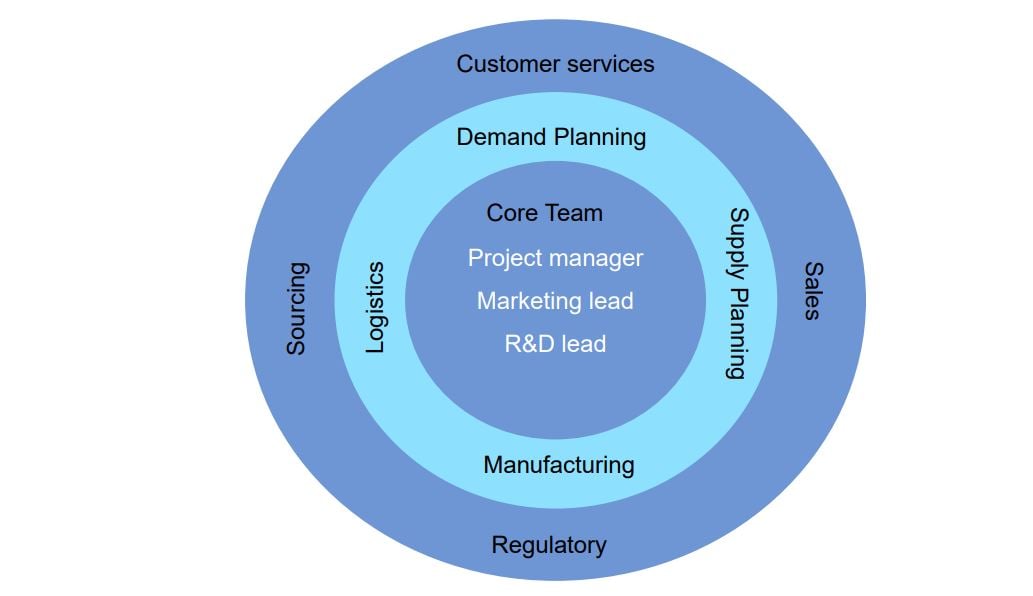If you thought the new product development process was going to be a walk in the park, you might need to take a look at a survey conducted by Gartner in 2019. The survey questioned CEOs about the success of new product introduction, and the numbers were sobering.
The survey found that 45% of product launches are delayed by at least one month, and 20% of these do so because they fail to meet internal targets.
The top reasons for new product introduction failure will probably not come as surprise to anyone already engage in product development — schedule delays, cost overruns and poor demand forecast, top the list.

What caused that lack of success? It all goes back to people and their failure to innovate or imagine, their failure to communicate, implement, or document. Large projects like a product development project are combinations of imagination and skill, technical prowess and attention to detail across disciplines. There are so many moving parts that it’s imperative that a process be put in place to manage the project.
The survey Gartner conducted was intended to determine some of the best practices being used by companies engaged in product development. Among the best practices Gartner suggests is the use of a Project Manager (PM) to coordinate the NPI activities. Surprisingly, 36 percent of the survey respondents don’t use a project manager and, "fewer than 20% of organizations see their product managers as driving innovation or improving collaboration within the company."
This survey revealed that product managers who prioritize their responsibility of improving internal collaboration are more likely to experience successful product launches.
Gartner also suggests companies use a cross-functional NPI team throughout the product launch. Here’s a graphic they used to illustrate the concept.

Graphic courtesy of Gartner
The Core Team, made up of the Project Manager, Marketing Lead and R&D Lead, are surrounded by the project principals from sourcing, logistics, customer service, manufacturing sales and other divisions as needed.
Gartner research director Janet Suleski described this cross-functional team as “dynamic,” with different principals joining the Project Manager (in the center) as needed during the life of the project.
Why You Should Use an NPI Checklist
When it comes to actually working the project, most suppliers/manufacturers will use a checklist, charter, punch list, whatever you want to call it. This document covers all the tasks and responsibilities, ensuring every detail of your product design is recorded and verified, and that everyone knows what needs to be done and when it needs to be finished.
We’ll call it the NPI checklist. It is the full list of work produced by the design team so that the NPI process can move ahead as planned.
The purpose of the document is the outline the scope and requirements of the project. It will include every detail regarding materials, testing and manufacturing processes. It describes who needs to have what items and when. It documents which phase of the product development timeline you’re in and lets you know if you’re ready to sign off on a particular phase of the project. It’s a living document, updated for changes during the project’s execution and monitoring phases.
As with anything, you’re likely to come up on some roadblocks, but having a well formulated NPI document will help ease even the rockiest road.
What Should Be in Your NPI Checklist?
It’s a good idea to build your checklist with input from members of the cross-functional NPI team. Each division will be able to offer suggestions about what should be included based on answers they'll need to get during the process. Here are a few other items that will help organize your checklist:
- List the criteria in the order they need to be accomplished.
- Make your list generic, able to be used regardless of material or manufacturing process.
- If a field isn’t required, mark N/A.
- Leave room next to each item for notes or comments.
List your project by name and any account or project number you’ve assigned to it.
Describe the part and include any internal identifying number you’ve given the project.
List the project initiation date and the estimated annual usage (EAU) of the project.
List the names and responsibilities of the project principals, for example:
- Project Engineer
- Supplier
- Sales Account Manager
- Customer Service Representative
- Customer Contact (technical)
- Customer Contact (purchasing)
- Project Coordinator
- Project Manager
Project Objective - Describe your project. What is it? Why is your company doing it? What is the business case?
Project Scope - Offer a high-level explanation of the project scope. How involved is it? Describe the manufacturing process you're using, whether or not tooling is needed, critical parts, mating parts and cosmetic requirements.
Sampling requirements - State the number of PPAP samples, number of T1 samples and other details around the samples, i.e. where they will be shipped and who will bear the shipping costs.
Customer testing requirements - List specific testing requirements including conflict minerals and third party certifications, as well as the testing schedule and costs.
Supply Chain - You might want to have a place on your checklist to list any components in your product that have the capability to throw a wrench into production because of supply chain issues. For example, the electronics components shortage is creating long lead times that is affecting production times. A single component can delay an entire project. This section on your checklist would make it easy to track.
Schedule - You will want to keep track of key dates such as:
- Sampling - ETA date
- First Production - ETA date
- Project Milestones, including Project Initiation, Drawing Release Date, Tooling Fabrication Completion, Sampling Shipment Date, PPAP Sample Approval, First Production, etc.
PPAP Checklist - Include your PPAP checklist (noting Level I,II,III requirements) as part of your NPI checklist.
Additional Notes - Leave space to add additional information and note the date when the document was amended.
NOTE >>> You can certainly include other items that are important to your process, and you could exclude those that aren't necessary. Again, the idea is to create a checklist reflecting your product development process, one that is generic enough to suit all your project types and one that keeps all the moving parts in order.
Tips for Salvaging a Troubled Project
Sometimes, despite the best of intentions and checklists, things can still go south. What do you do? How can you save a project that's headed for the rocks? Gartner researcher Matt Light developed a 10-step process for rescuing projects endangered by cost overruns, delays, resources that have dried up and other perils.

1. Press the brakes: This can be a full stop or gentle tap, but the point is, the project needs to slow down so the team leadership can get a better look at what's going on.
2. Make time to talk: Everyone involved in the project needs to be at the table and everyone should have (as they say in the movies) "permission to speak freely." It's only with open and honest dialog of what's going on that you will get to the bottom of the problems and begin to find the solution.
3. Draw a line in the sand: Boundaries are our friend. Sometimes a project can't be rescued and it's good to know that. But you can't know that until you know when it's too far. Know when to stop trying by drawing that line.
4. Understand the root cause: The best way to get to the root cause, or 'why' is to ask detailed questions which generally net detailed answer. A recommended technique is the "five whys." Here's an example:
- First why: The battery is dead.
- Second why: The alternator is not functioning.
- Third why: The alternator belt has broken.
- Fourth why: The alternator belt was well beyond its useful service life and not replaced.
- Fifth why: The vehicle was not maintained according to the recommended service schedule (root cause).
5. Recognize the risks: The fact that this project is already in rescue mode makes it riskier than usual. New risks may arise as you proceed. Stay aware of these new risks especially in these key areas: complexity, technology, operations, external, organizational, schedule and financial.
6. Prepare to fight for the project: If you're going to make this work you might have to do battle with stakeholders and decision makers to create a plan of action. Items you'll need for the meeting include:
- Preparing materials and gathering information (current reports, statistics) to facilitate discussion.
- Soliciting input from stakeholders attending the meeting.
- Creating an agenda in advance of the meeting.
7. Meeting with stakeholders: Gartner's Light suggests that all stakeholders and decision makers meet in one room, ideally face to face, to work through different scenarios and agree on next steps. The key questions to consider are:
- Is the business case sill valid if we take into account the rescue costs?
- If not, is there a new business case that justifies the rescue?
As painful as it may be, killing the project should always be an option on the table.
8. Decide the next step(s): Whatever decisions are made, it's important to move on them quickly. For the sake of the project and to maintain momentum, move on the next steps within 24 to 48 hours of the meeting with stakeholders.
9. Confirm the plan: Make sure everyone understands who is responsible for what and whether resources are still available or need to be replaced.
10. Hit the reset button: You've started over. There's a new plan, parameters, scope, goal. There's no need to live in the past. You've gone through the 'lesson's learned' phase, so affirm your goals and move on.
Whether it's putting together a chair from IKEA or starting a new product line, having the right tools for the job makes all the difference in the world. The right checklist, process or mindset can put your product development project on the road to success.
Does your company use an NPI checklist? Does it include other items? What would you add? Let us know in the comment section below.
>>>Are you ready to find partner to help guide your project? Click on the download below for our FREE GUIDE!<<<




.jpg?width=176&height=56&name=MR_associatedNetwork_logo%20(1).jpg)